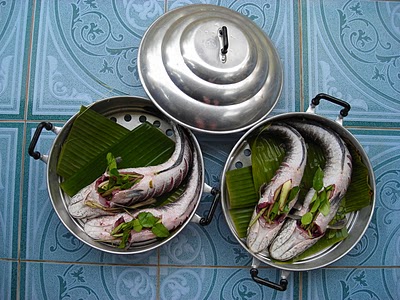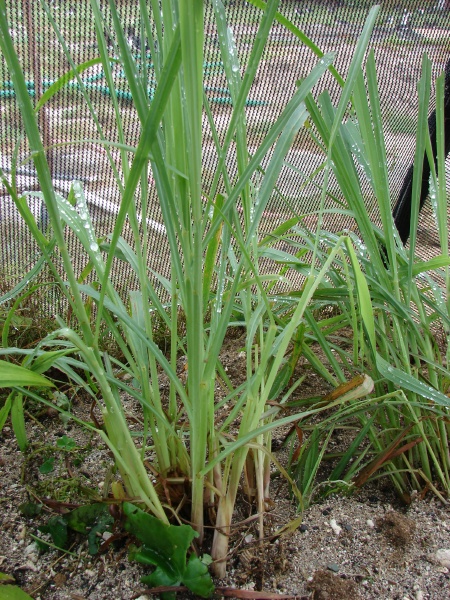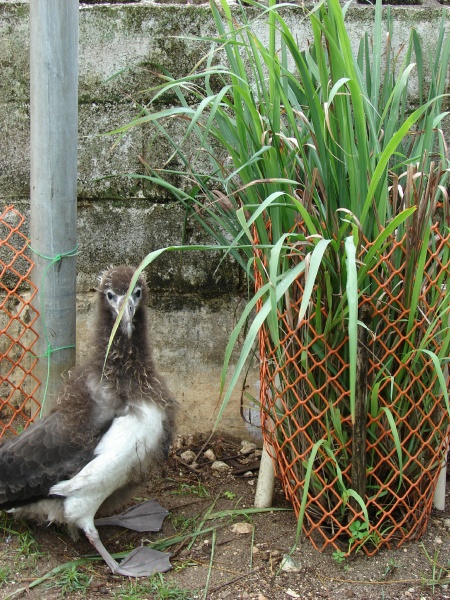
Interactions
Like all organisms, Cymbopogon citratus holds a place in the food web. As an autotrophic plant species, Lemongrass is a primary producer and serves to provide food for the other trophic levels.
We ourselves, consume this plant as a spice or flavoring in many
foods and beverages. We chop the tender inner core of the plant and
use in our favorite poultry and Oriental dishes, or we used the
tough outer parts of the stalk to flavor our different teas and
soups. However, we only do this with the fresh stalks because once
dried out they yield little flavor. See
nutrition for reasons why le mongrass why it is a sustainable
food source. Another delicious plant commonly used as as seasoning
is Sage.
Another great tea is made using the organism
Chenopodium ambrosioides
mongrass why it is a sustainable
food source. Another delicious plant commonly used as as seasoning
is Sage.
Another great tea is made using the organism
Chenopodium ambrosioides
Cymbopogon citratus also does many other great things for us. Many people believe that it holds some medicinal effects on the body. Lemongrass has long since been used in Brazil as an old "folk remedy" for treating nervous and gastrointestinal upsets as well as fevers. A study was conducted to test this theory, and it was proved that, in a few instances, injection of 200 mg/kg Citral (the main component of the essential oil in Brazilian lemongrass) and doses of up to C208 of an infusion made from pouring boiling water over the leaves did demonstrate these effects. For information on another interesting, medicinal plant see St. Johns Wort.
It was also discovered in that the Citral in the oil has cancer
fighting abilities. It was shown that 1 gram of Citral was enough to
cause malignant cancer cells to undergo programmed cell death. It
was also shown in a study by Food and Nutrition Research institute
that when boiled, every 100 grams contains up to 24,205 micrograms of
the cancer preventative anti-oxidant beta-carotene.
The detoxification properties of lemongrass were investigated at University of Wisconsin, and it was found that the oil in during the clinical trial, the responders cholesterol had been lowered by as much as 38 points. After the study, their cholesterol they returned back to their normal levels. It is believed that reduction of fat and cholesterol increases blood pressure and circulation.
Lemongrass oil was also proved to be an fungicide in an experiment conducted on the effects of Cymbopogon citratus on Aspergillus flavus. This fungus had developed on the staple food rice, causing an issue throughout many countries. In effort to create a natural remedy, the oil was applied to the rice, revealing that the toxicity of the oil inhibited the growth of the fungus.
Cymbopogon citratus oi l has also been used as an antibacterial
agent throughout African countries. This, like the fungicide claim
was also studied in lab. It was revealed that when steamed, the
leaves release and oil that contains three components that they were
able to test on gram- positive bacterial organisms with a thick peptidoglycan layer, and gram-negative bacterial organisms
with a thinner peptidoglycan layer that is located beneath an outer
membrane. The α-citral (geranial) and β-citral
(neral) both exhibited antibacterial action on both types of
bacteria oraganisms; however myrcene, the third component in the
oil, did not exhibit antibacterial action unless it was combined
with one of the other two components.
l has also been used as an antibacterial
agent throughout African countries. This, like the fungicide claim
was also studied in lab. It was revealed that when steamed, the
leaves release and oil that contains three components that they were
able to test on gram- positive bacterial organisms with a thick peptidoglycan layer, and gram-negative bacterial organisms
with a thinner peptidoglycan layer that is located beneath an outer
membrane. The α-citral (geranial) and β-citral
(neral) both exhibited antibacterial action on both types of
bacteria oraganisms; however myrcene, the third component in the
oil, did not exhibit antibacterial action unless it was combined
with one of the other two components.
Upon interacting with certain insects, like the Tribolium castaneun Herbst for example, Cymbopogon citratus's oil has been shown to work as an insect repellant. When isolated from the plant, the geranial, neral, and geraniol in the oil are shown to have 100% repellency of the insects at 2 hr exposure when diluted to 1.0 mLˆ-1. The oil exhibited a high toxic potency, and was proven to be successful as and insect repellent.